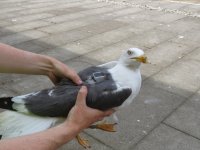 |
| Tags could provide vital data |
The tags have been designed to sit between a bird’s wings like a backpack and will allow researchers to understand many different aspects of these birds’ lives around windfarms, including, crucially, whether gulls are at risk of death through collision with turbine blades.
Says the BTO's Emily Scragg: "The tagging will provide an unprecedented opportunity to discover how seabirds respond to the construction of an offshore wind farm as well as to understand further their movements through the year.”
“I can’t wait to see the results!”
Equally enthusiastic is Dong Energy's lead environmental and consent specialist, Allen Risby, who says: “We are keen to learn more about how these gulls behave around offshore windfarms as they fly above, below or between the individual turbines.
“They might provide opportunities for the gulls, too.”
The study is being jointly funded by the Walney Extension and Burbo Bank Extension projects, two of the offshore wind farms that Dong is currently constructing off the northwest coast.
Tagging was undertaken this year during the gulls’ summer breeding season, and the work has already shown some differences in the use of offshore areas by birds from South Walney and Barrow.
But the really important data will not emerge until the construction phase of the windfarms through to when the turbine blades start turning.
No comments:
Post a Comment